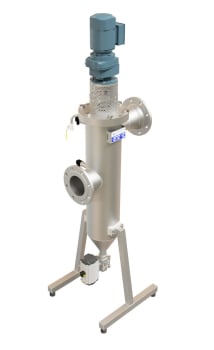Self-cleaning Filters MKS-137
HiFlux MKS-137 filters are designed as compact manual self-cleaning filters with many applications. The robust construction of the filter makes it suitable for cleaning practically all liquids, including tungoil, lubricating oil, bitumen, grease, paint, toothpaste, water, fermentation liquids, petrol, syrup, condensate, CIP liquids, antibiotic suspensions, etc.
The filter is used where continuous operation without interruption in the flow is desired. The cleaning process is carried out by turning the hand wheel when the differential pressure has reached a level where cleaning is required. The dirt is compressed in the filter until it is drained away.
The filtration principle is based on an asymmetric edge-gap element, with the dirt particles being retained on the surface of the filter element.
In the cleaning cycle the filter insert rotates, making three fixed blades scrape the dirt off into a sludge chamber from where it is drained out of the filter at appropriate intervals. This results in defined absolute cleaning of the filter and controlled drainage.
As the cleaning process does not require the filter to be blocked off from the rest of the system, the flow in the filter will continue during the scraping process. This means that the filter can work continuously, and that the flow is not interrupted during the cleaning process.
The cleaning process is started when the hand wheel is turned manually. How often this should be done depends to a large extent on the dirt content in the liquid to be filtered, the filtration range and the process. For some processes the scraping process must be carried out at very short intervals to ensure that the filter surface remains active and clean. For other processes daily or weekly cleaning is sufficient. Drainage of the dirt takes place through the foot valve, which should be opened manually after a given number of scrapings or at suitable intervals. This means that the dirt is concentrated before it is pushed out of the filter, which reduces product loss significantly.
Normally drainage is carried out over a period of 1-3 seconds, during which time a minor drop in system pressure may occur. The liquid flow in the filter is only reduced by approximately 5-10% for the short interval in which drainage takes place.
In the design of the filter importance has been attached to making the con-struction robust and reliable. By limiting the number of moving components, wear and maintenance requirements are minimised. The simple construction makes the filter so easy to service that there is no need for external assis-tance in this connection.
Capacity: (at a viscosity of 1 cSt and as a pressure filter)
| Differential pressure clean | MKS‐137/80 50 - 3000 * |
MKS‐137/100 50-130 * |
MKS‐137/100 250 - 3000 * |
MKS‐137/125 50 * |
MKS‐137/125 100 - 130 * |
MKS‐137/125 250 - 3000 * |
|---|---|---|---|---|---|---|
| 0,05 | 25 | 30 | 35 | 45 | 50 | 50 |
| 0,10 | 41 | 52 | 63 | 62 | 74 | 74 |
| 0,15 | 55 | 65 | 82 | 85 | 90 | 92 |
| 0,20 | 66 | 85 | 95 | 93 | 100 | 107 |
| 0,30 | 83 | 105 | 120 | 118 | 125 | 132 |
| 0,40 | 97 | 125 | 140 | 138 | 142 | 150 |
*) Capacity in m3/h / micron
The filter should be installed in systems which have a positive pressure of at least 0.1 bar in relation to the surroundings to ensure efficient sludge removal.
| General Numbers | |
|---|---|
| Filtration Range | 50 - 3000 µm |
| Power supply | 3 x 230/400V, 50Hz |
| Max working temperature | 110 °C |
| Max differential pressure | 2,5 (8) bar |
| Design Pressure | 16 bar |
| Capacity | Maks 100 m3/h |
| Test Pressure | 24 bar |
| Skrapesystem | Roterende |




